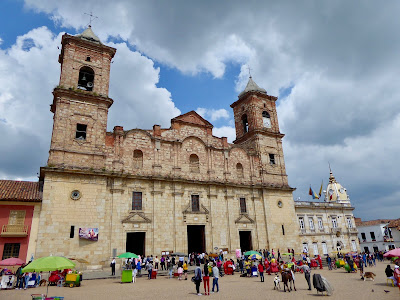San Agustin is an unassuming small town in the Andes Mountains of western Colombia, but it’s surrounded by what’s said to be the largest complex of megalithic funerary monuments, statues and structures, burial mounds and terraces in Latin America, some of which are estimated to date back to before 1,000 B.C.
They’re most concentrated in an area five kilometres outside of town which since 1931 has been the San Agustin Archaeological Park. It was designated a UNESCO World Heritage Site 64 years later. A bus or taxi can get you there easily and economically, and 50,000 pesos (approximately $17.50 Canadian) gets you a two-day entry passport and a guide to take you around and explain what you’re seeing, although little is known about the various monuments.
The guide spoke very minimal English, but we had a fully bilingual tour leader from Tucan Travel to translate what he said about the history and mystery of the relics. The guide further entertained our group by playing a pan flute and creating a finger painting of various colours derived entirely from different plants he found as we walked.
A trail through a scenic and calming cloud forest leads to the archaeological park’s four main sites, which are clustered and within easy walking distance of each other.
About 20 earthen mounds within the park boundaries, some measuring as much as 30 metres in diameter, covered large stone tombs of the upper and ruling class members of the long gone society.
Many of these tombs feature statues of gods, supernatural beings and animals including jaguars, crocodiles and bats, all carved from volcanic rock. While much is believed to be still buried, there are approximately 200 known statues within the park. The tallest one excavated so far is about seven metres tall, and many others are more than four metres and weigh several tons.
The ancient San Agustín sites were abandoned around 1350 AD and rediscovered during the 18th and 19th centuries, which led to people looting and disturbing the monumental tombs. There was little in the way of great riches to be found, aside from an archaeological standpoint, which likely aided in the preservation of the carved and painted stones. Much of the paint has worn away, but it’s still evident on some statues.
One of the most important and impressive sites of the park is the ceremonial Lavapatas fountain, which is comprised of a set of carved rocks on the bed of the creek that bears the same name and is believed to have been related to cults that worshipped water. The channels that carry water up to three ponds are silhouettes of snakes and lizards.
Aside from the tombs, statues and fountain, the elevated location of part of the archaeological park also provides excellent views of the surrounding countryside and mountains.
After walking around the park for more than three hours, I spent another 30 minutes visiting a small on-site museum to learn more about the area, its significance and the civilization that created the things in the park, as well as to see tools, urns and other objects related to past inhabitants.
A taxi took me into town, which like most Colombian cities has a main central square dominated by a church and important public buildings. There wasn’t a lot to see, but I walked around for an hour to check out the architecture and pick up snacks and a bottle of rum at a grocery store.
I caught another taxi to my lovely accommodations outside of town at the rustic Hostela Anacona, which offered green vistas, bright flowers, tasty food and inexpensive cans of cold Club Colombia Dorada beer.
There are two other archaeological sites, El Tablon and La Chaquira, not far from the hotel. The former offered more statues to look at, but the longer walk to the second one was a nice, light hike that ends with great views of a Magdalena River valley and waterfalls as well as a few small carvings in large rocks.
The Magdalena, the most important river in Colombia, crosses the country along 1,500 kilometres from south to north before emptying into the Caribbean Sea. I encountered it a few times during my two weeks in the country.
The walk back to the hotel provided photo opportunities of vividly coloured plants as well as local people, animals and buildings.
The next day would present the longest and roughest bus ride of my Colombian trip, but I was prepared for it after this relaxing respite in San Agustin.



















